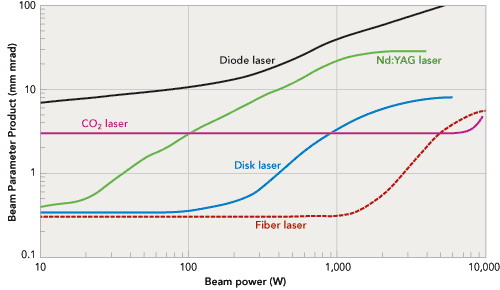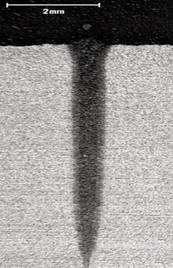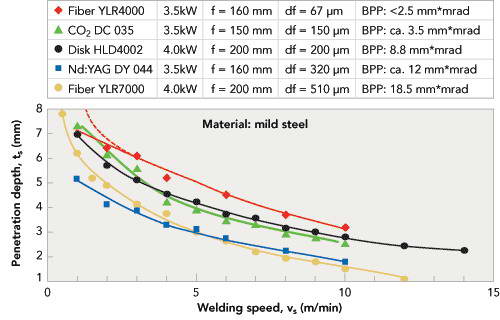Application of fiber laser in welding industry
With the recent development of high-brightness lasers, opportunities for laser material processing applications are increasing in many new fields. Let's take the example of a very mature gem-rod solid-state laser. The two completely different development directions are worthy of attention. On the one hand, the gemstone rod expands its diameter and the length is reduced to several hundred micrometers, which makes the disc laser. On the other hand, the length of the rod is increased and the diameter is reduced, which becomes a fiber laser.
When it comes to fiber lasers, the length of the fiber ensures that the beam quality is close to the diffraction limit (in a laser of a given wavelength, the theoretical limit, or the smallest possible focus size). The cavity of this laser does not require any adjustment, and the beam quality is regulated by the physical properties of the fiber. In addition to the above two advantages, fiber lasers should also understand that their pump energy can be coupled to the active fiber or stimulated fiber through the transmission fiber, thus eliminating the optical adjustment of the diode pump source to the fiber laser. The tedious process.
Figure 1 shows the relationship between beam quality parameters (BPP) and output power for different industrial lasers. The smaller the BPP value, the better the beam quality. Compared to other lasers, fiber lasers exhibit better beam quality (only slightly less than the CO2 laser in the range of 5,000 to 10,000 watts). At Fraunhofer we agree that fiber lasers have a broader future.

In Dresden, Germany, Fraunhofer IWS and IWS in Plymouth, Michigan, USA, we have the various fiber lasers in the table below for industrial process development.
These fiber lasers have the following features: very small size, there is no need for any adjustment between the pump source and the final optical focusing system, no adjustment is required, high electro-optical conversion efficiency (25-30%) . In addition, fiber lasers have excellent beam quality and an extremely long pump source life (over 50,000 hours). We can use a small beam-expanding collimation system to perform high-speed beam steering with a small galvanometer system.
The 15 micron diameter fiber length is limited to a few meters, and because of the Raman scattering effect, it will reduce the output energy when using longer fiber transmissions. The 50 micron fiber is limited to a length of 15 meters, and the length of the fiber of 100 and 200 microns is not limited!

If a shutter or fiber-to-fiber coupling is used, it must be 100 micron fiber, 50 micron fiber, or 200 micron fiber, 100 micron fiber. In the above two conditions, the beam quality can reach 8mm.mrad. This is comparable to a disc laser, and as a result of the soldering, the two lasers are very close.
Taken together, the fiber laser system used in Fraunhofer is very stable and has not experienced any problems. The lamp pumping system itself has a lot of conventional problems. Some other fiber laser users have mentioned that the optical reflection problem in operation has not caused any trouble to us so far. Our experimental data shows that optical reflection does not have any effect on the output power of the laser. Even so, we do not advocate the use of a beam design perpendicular to the workpiece in practice, but use an angle that is slightly tilted by about 6 degrees. There is no problem in cutting and welding steel and aluminum, but in the same operation, when the workpiece is made of copper, the situation is more complicated and needs to be handled with great care.
In our research, due to the excellent beam quality of fiber lasers, the depth and speed of welding can reach the narrow and narrow welds equivalent to electron beam welding. Figure 2 shows the effect of actual welding. 4 kW fiber laser welding 8 mm thick carbon steel plate (mechanism in the car gearbox).

For low deformation welding, fiber lasers appear to be the best choice at the moment. This is not only widely used in gear transmissions, but also has great advantages in remote welding.
Due to the extremely high beam quality, we can use very compact, compact focusing and scanning optics without changing the welding parameters and for far field technology. In both cases, the excellent beam quality of the laser produces a specific welding plasma (compared to Nd:YAG and disc lasers), and a shielding gas must be used, otherwise absorption and bulk scattering effects will occur.
Figure 3 shows test data for weld speed response and depth for fiber, disc, Nd:YAG, and CO2 laser systems. Due to the limited energy range of our CO2 lasers, we only conducted a comparative test on a 3.5 kW CO2 laser. The welding data of the disc laser is somewhat deviated because we are using TRUMPF's HLD4002 disc laser with 4kW output power. Similarly, we used data from other fiber lasers, BIAS Bremen's 4.0 kW YLR7000 fiber laser (300 micron fiber). In summary, the following data shows that not different lasers will result in different welding results, but different beam qualities. Just like two different beam qualities and other fiber lasers with very close parameters, the test results are quite different.

Conclusion It can be stated that high power fiber lasers are ideal for different welding and cutting applications. High beam quality provides more opportunities and better performance than other laser systems.
On the other hand, buying a laser should also consider a number of important factors, including investment costs, operating expenses, maintenance and repair costs. However, the most important point is that the final result must be repeated, which requires the beam quality to be very stable, which is one of the most important fundamental factors.
OVERVIEW
Phlizon LED Grow Light bars made in the China, full spectrum led grow light bars for plants growing,designed specifically for use as supplemental greenhouse lighting. 4 bars,6 bars ,8 bars 10 bars ,12 bars for choice.Adjustable bar quantity to make much more convenient repair and replacement in the future
Safety FCC ETL Certified and IP54 Rated.Passive cooling,extrusion pure aluminum can 100% ensure heat dissipation. Plants will grow better under the Full Spectrum LED Grow Lights, as well their yield. will increase hugely.
FEATURES
High power branded Samsung chip with high Par Value
Light distributed evenly in every spot and cover larger area
Full-cycle spectrum optimized for rapid growth and complete plant development
Full spectrum for different period of growth
Customizable spectrum ,any spectrum can be OEM/ODM,at any stage of growth accordingly
Passive cooling (no fans),Aluminum material and heat-dissipation design.
APP WiFi to make operation.Standard without dimming, dimming with different PPFD.
Energy Saving, environmental friendly
Suitable for a wide range of vertical farming lighting applications like vegetables, herbs in shelfs or CC racks.
3-5 Year Warranty
Applications
Hydroponics, Horticulture, Agriculture and Greenhouse
Locations: Farm, Exhibition, Garden, Home, Urban, Bonsai, and University Lab
Growth of Fruits, Vegetables, Flowers and so on
Seeding, Rooting, Breeding, Flowering and Fruiting period
800W Led Grow Light,800W Grow Light,800 Watt Grow Light,Led Grow Light Multiple Bars
Shenzhen Phlizon Technology Co.,Ltd. , https://www.philizon.com